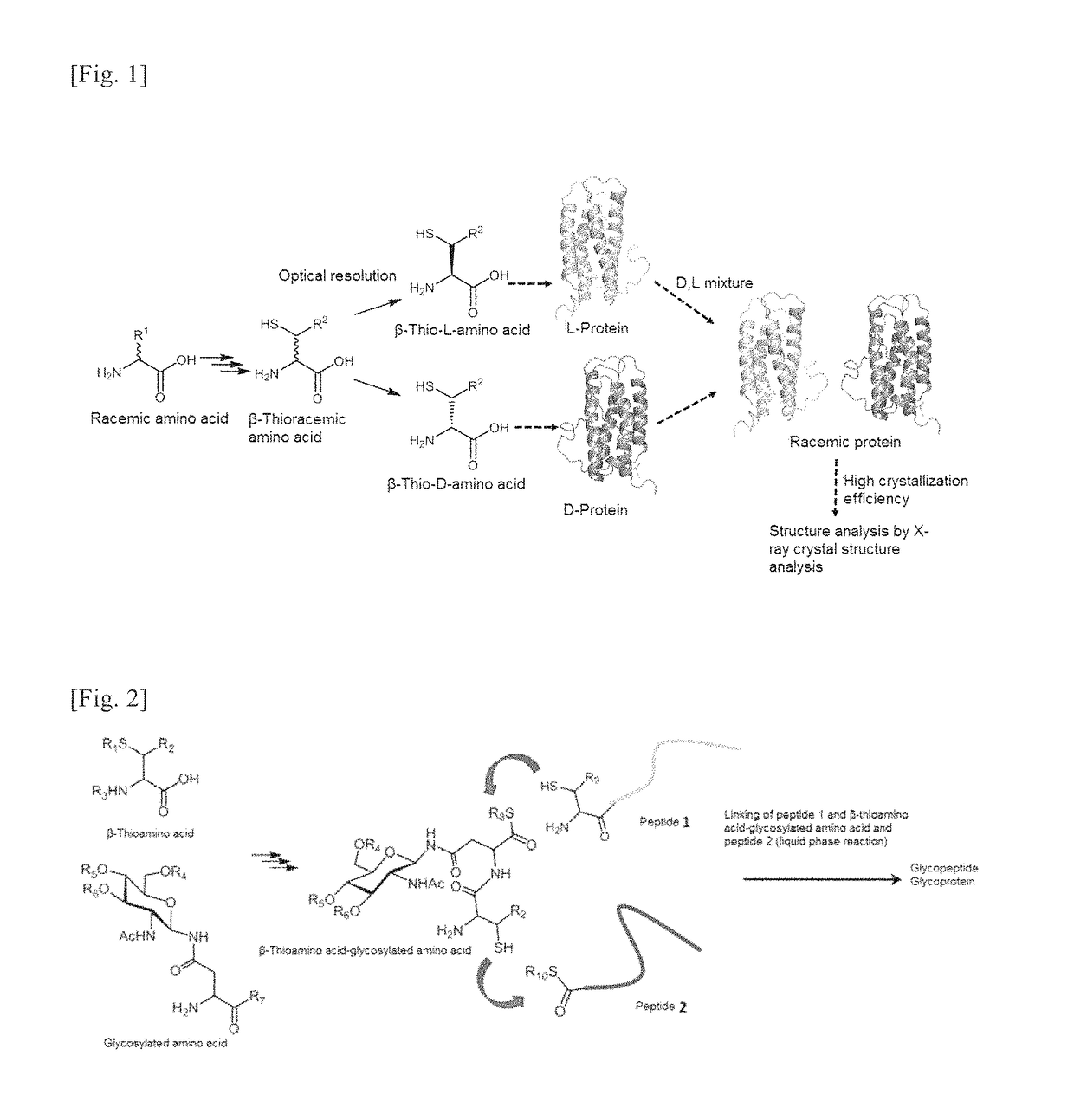Method for producing D-form or L-form amino acid derivative having thiol group
a technology of thiol group and amino acid, which is applied in the direction of enzymology, organic racemisation, transferases, etc., can solve the problems of difficult to manufacture the amino acid of interest with good yield amount and rate by such a method, and the limitations of amino acids that can be the linking site are still very limited, so as to achieve superior reaction efficiency, easy manufacturing, and high yield
- Summary
- Abstract
- Description
- Claims
- Application Information
AI Technical Summary
Benefits of technology
Problems solved by technology
Method used
Image
Examples
synthesis example 1
D,L-phenylalanine methyl ester hydrochloride (Compound 6)
[0204]In the presence of argon, D,L-phenylalanine (10.0 g, 60.5 mmol) was added to methanol (48.4 mL), the solution was cooled to 0° C., and then thionyl chloride (4.8 ml, 66.6 mmol) was added dropwise. This was then stirred under reflux for 1 hour. The reaction solution was concentrated under reduced pressure, and then recrystallization was carried out with a mixed solvent of 5 ml methanol and 80 mL diethyl ether to obtain D,L-phenylalanine methyl ester hydrochloride (Compound 6) (11.8 g).
synthesis example 2
N,N-DiBoc-D,L-phenylalanine-methyl ester (Compound 7)
[0205]Compound 6 (11.8 g) was suspended in THF (292 mL), then cooled to 0° C., to which Na2CO3 (7.0 g, 1.0 eq.) dissolved in water (164 mL) was added. Then, (Boc)2O (28.7 g, 2.0 eq.) was added dropwise, and this was stirred at ordinary temperature for 2 hours. The compound produced by the reaction was extracted with ethyl acetate, and then washed with saturated ammonium chloride aqueous solution, water, and saturated saline. The organic layer was dried with magnesium sulfate, filtered, and concentrated under reduced pressure to obtain a crude product of N-Boc-D,L-phenylalanine-methyl ester.
[0206]This crude product was further dissolved in acetonitrile (202 mL), 4-dimethylaminopyridine (DMAP) (7.4 g, 1.0 eq.) was added as a catalyst, then (Boc)2O (39.6 g, 3.0 eq.) was added, and this was stirred at room temperature for 12 hours. This was then concentrated under reduced pressure, extracted with ethyl acetate, and washed with saturat...
synthesis example 3
N,N-DiBoc-β-bromo-D,L-phenylalanine-methyl ester (Compound 8)
[0207]In the presence of argon, Compound 7 (5.0 g, 13.2 mmol) was dissolved in carbon tetrachloride (264 mL), N-bromosuccinimide (2.3 g, 1.0 eq.) was added, and this was then reacted under reflux for 1 hour under exposure to light by a 200 W incandescent lamp. The experiment system was covered with aluminum foil in order to intensify the light. Subsequently, after the reaction, this was cooled to room temperature, and succinimide was removed by filtration. This was further concentrated under reduced pressure to obtain Compound 8 (5.7 g).
[0208]C20H28BrNO6[M+Na]+: Cal 480.00. Found 480.16.
[0209]1HNMR (400 MHz) δ: 7.55-7.24 (m, 5H), 5.76 (d, 1H), 5.74 (d, 1H), 5.68 (d, 1H), 5.61 (d, 1H), 3.80 (s, 3H), 3.59 (s, 3H), 1.58 (s, 9H), 1.38 (s, 9H)
PUM
| Property | Measurement | Unit |
|---|---|---|
| temperature | aaaaa | aaaaa |
| reaction temperature | aaaaa | aaaaa |
| reaction temperature | aaaaa | aaaaa |
Abstract
Description
Claims
Application Information
 Login to View More
Login to View More - R&D
- Intellectual Property
- Life Sciences
- Materials
- Tech Scout
- Unparalleled Data Quality
- Higher Quality Content
- 60% Fewer Hallucinations
Browse by: Latest US Patents, China's latest patents, Technical Efficacy Thesaurus, Application Domain, Technology Topic, Popular Technical Reports.
© 2025 PatSnap. All rights reserved.Legal|Privacy policy|Modern Slavery Act Transparency Statement|Sitemap|About US| Contact US: help@patsnap.com



